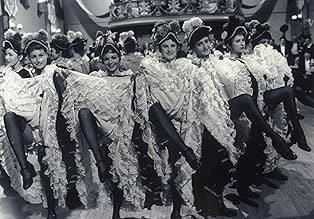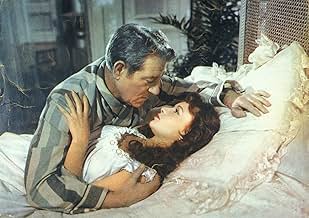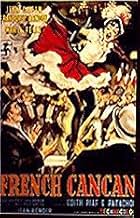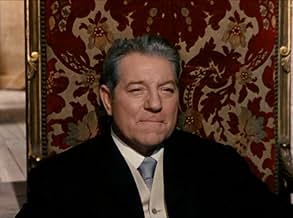IMDb-BEWERTUNG
7,3/10
4672
IHRE BEWERTUNG
Füge eine Handlung in deiner Sprache hinzuThis comedy drama from Jean Renoir chronicles the revival of Paris' most notorious dance as it tells the story of a theater producer who turns a humble washerwoman into a star at the Moulin ... Alles lesenThis comedy drama from Jean Renoir chronicles the revival of Paris' most notorious dance as it tells the story of a theater producer who turns a humble washerwoman into a star at the Moulin Rouge.This comedy drama from Jean Renoir chronicles the revival of Paris' most notorious dance as it tells the story of a theater producer who turns a humble washerwoman into a star at the Moulin Rouge.
- Regie
- Drehbuch
- Hauptbesetzung
Empfohlene Bewertungen
"French Cancan" is one of my favorite all time movies. It's an excellent film. There's color, there's humor, there's music. It's a very good portrait of the so called Belle Époque, though Jean Renoir's priorities were always to show a creation, a fantasie. So the film isn't a historical movie. The final sequences in which the girls dance cancan are unforgettable images. It's a film you shouldn't miss.
Of the several Jean Renoir films I have seen, this was by far the most interesting.
This film was obviously the inspiration for the Baz Luhrman film Moulin Rouge. Luhrman even appropriated one of the original songs for use in his film.
The film tells the story of the construction of the Moulin Rouge for the presentation of a revival of the CanCan. Although characterization is a bit weak and most characters are little more than stereotypes, the plot, music, action, and spectacular visuals more than make up for the shortcomings.
This is a loving tribute to the Paris of the impressionist period and is filmed beautifully in color.
Does anyone know if there is any truth to the tale?
This film was obviously the inspiration for the Baz Luhrman film Moulin Rouge. Luhrman even appropriated one of the original songs for use in his film.
The film tells the story of the construction of the Moulin Rouge for the presentation of a revival of the CanCan. Although characterization is a bit weak and most characters are little more than stereotypes, the plot, music, action, and spectacular visuals more than make up for the shortcomings.
This is a loving tribute to the Paris of the impressionist period and is filmed beautifully in color.
Does anyone know if there is any truth to the tale?
A charmingly amoral club owner sets his sights — amorous and financial — on a beautiful, naïve blue collar girl and propels her to the height of celebrity thanks to her titillating dance skills.
It may sound like a contemporary, cutting edge urban drama, but French Cancan was made in 1956 by famed director Jean Renoir. The movie — a darkish comedy with a progressive take on sexuality — chronicles the birth of the Moulin Rouge. Legendary Jean Gabin plays Danglard, a world-weary hustler, club owner and anti-hero for the ages, who makes no pretense of his philandering and amorous proclivities. He's casting about for a new lover and a new money making venture when his current club fails and he grows bored with his mistress. He discovers a beautiful young washer girl, Nini, whom he convinces to headline at his new "concept" club, the Moulin Rouge, making it a hot spot and her a celebrity before the doors even open.
It doesn't hurt that Nini's moody ex-lover — a sullen baker (le petit grump) — injures Danglard in a fight and an even moodier Russian count becomes suicidal because Nini spurns his advances. As the salacious headlines drive up public interest, they learn the club will feature the cancan in all it's thigh-revealing, petticoat-flashing, bawdy glory — a disreputable dance to begin with now fallen completely out of favor.
The movie is a riot with memorable characters, beautiful, dizzying club and dance scenes, a few titillating moments that must have pushed the limits 60 years ago and swooning French girls forever throwing themselves desperately into and out of the arms of their lovers. You almost forget that it's a musical, so seamlessly are the musical and dance scenes integrated into the plot.
Danglard's gangly side kick is hilarious as is the whistler. Most delightful of all was seeing and hearing the divine Edith Piaf on screen after listening in awe to her songs all these years.
The movie is best enjoyed with absinthe in honor of the absinthe consumed on screen — as fate would have it, we had some delightful Oregon-made absinthe that night — or lots of champagne.
-- www.cowboyandvampire.com --
It may sound like a contemporary, cutting edge urban drama, but French Cancan was made in 1956 by famed director Jean Renoir. The movie — a darkish comedy with a progressive take on sexuality — chronicles the birth of the Moulin Rouge. Legendary Jean Gabin plays Danglard, a world-weary hustler, club owner and anti-hero for the ages, who makes no pretense of his philandering and amorous proclivities. He's casting about for a new lover and a new money making venture when his current club fails and he grows bored with his mistress. He discovers a beautiful young washer girl, Nini, whom he convinces to headline at his new "concept" club, the Moulin Rouge, making it a hot spot and her a celebrity before the doors even open.
It doesn't hurt that Nini's moody ex-lover — a sullen baker (le petit grump) — injures Danglard in a fight and an even moodier Russian count becomes suicidal because Nini spurns his advances. As the salacious headlines drive up public interest, they learn the club will feature the cancan in all it's thigh-revealing, petticoat-flashing, bawdy glory — a disreputable dance to begin with now fallen completely out of favor.
The movie is a riot with memorable characters, beautiful, dizzying club and dance scenes, a few titillating moments that must have pushed the limits 60 years ago and swooning French girls forever throwing themselves desperately into and out of the arms of their lovers. You almost forget that it's a musical, so seamlessly are the musical and dance scenes integrated into the plot.
Danglard's gangly side kick is hilarious as is the whistler. Most delightful of all was seeing and hearing the divine Edith Piaf on screen after listening in awe to her songs all these years.
The movie is best enjoyed with absinthe in honor of the absinthe consumed on screen — as fate would have it, we had some delightful Oregon-made absinthe that night — or lots of champagne.
-- www.cowboyandvampire.com --
10bob998
This is my favorite Renoir from the Fifties. It's the story of how Henri Danglard built and launched the Moulin Rouge nightclub; we see the workmen blasting at the site to get construction underway, and the training of the dancers. Finally, the giddiness of opening night and the long sequence of cancan dancing. Financial problems and the ego displays of the performers are described.
Gabin is in great form as the easy-going Danglard--see him deal humorously with Nini's violent boyfriend. Gianni Esposito is moving as the wistful Prince who is courting Nini. Maria Felix, with that amazon's body, is imposing as the egotistical Lola, Danglard's first lover. Finally Françoise Arnoul as Nini the washing girl who ends up dancing for Danglard, and becoming his girl, is just stunning; her loveliness and pert charm will win you over.
A bonus: we get Edith Piaf, Patachou, André Claveau and other stars in cameos playing the stars of a century ago who ruled over the Moulin rouge.
Gabin is in great form as the easy-going Danglard--see him deal humorously with Nini's violent boyfriend. Gianni Esposito is moving as the wistful Prince who is courting Nini. Maria Felix, with that amazon's body, is imposing as the egotistical Lola, Danglard's first lover. Finally Françoise Arnoul as Nini the washing girl who ends up dancing for Danglard, and becoming his girl, is just stunning; her loveliness and pert charm will win you over.
A bonus: we get Edith Piaf, Patachou, André Claveau and other stars in cameos playing the stars of a century ago who ruled over the Moulin rouge.
The story is simple but the execution is marvelous. A Belle Epoque impresario, down on his financial luck, is going to open a new club, the Moulin Rouge, with a new dance, the French cancan. He encounters a working girl and makes her a dancer. She'll become a star. There are several crises to overcome before that happens.
The movie is Jean Renoir's tribute to show business, and he puts it on the screen with color, verve, humor, and humanity. There are wonderful performances by all the actors. The leads are Jean Gabin as Henri Danglard, the impresario; Francoise Arnoul as Nini, the girl who'll become a star; and Maria Felix as Lola de Castro, an overwhelmingly tempestuous beauty and Danglard's lover at the start. Gabin exudes confidence, worldly humor and dedication to show business. He even dances a bit. Arnoul is first rate, too. It looks like she was doing her own dances, and as an actress think of a young Leslie Caron with brains and charm.
The climax of the movie is the opening of the club, with Felix's star dance, comic songs, a whistler, a Danglar-discovered singer, all moving toward the introduction of the French cancan. The crises happen and are resolved. Then the cancan explodes. Dancing girls come bursting out from the stage, the front of the theater, through posters, down ropes from the balcony. The house swirls with the black tie and tails of the swells and the garish colors of the dancers' gowns. The cancan number lasts probably ten or fifteen minutes or so, all music and gaiety, all high kicks and splits. It's amazing when row after row of the dancers, moving toward the camera through the audience, leap up, legs extended straight forward and backward, backs arched, then land on the dance floor in full splits. I didn't know whether to shout or wince.
The last scene of the movie is outside the club, shot from the cobblestone street looking at the entrance. It's a medium shot and from the side street a happy, inebriated fellow in black tie and top hat staggers across, pauses to tip his hat at the camera, then staggers off. A completely charming ending.
This really is a marvelous movie.
The movie is Jean Renoir's tribute to show business, and he puts it on the screen with color, verve, humor, and humanity. There are wonderful performances by all the actors. The leads are Jean Gabin as Henri Danglard, the impresario; Francoise Arnoul as Nini, the girl who'll become a star; and Maria Felix as Lola de Castro, an overwhelmingly tempestuous beauty and Danglard's lover at the start. Gabin exudes confidence, worldly humor and dedication to show business. He even dances a bit. Arnoul is first rate, too. It looks like she was doing her own dances, and as an actress think of a young Leslie Caron with brains and charm.
The climax of the movie is the opening of the club, with Felix's star dance, comic songs, a whistler, a Danglar-discovered singer, all moving toward the introduction of the French cancan. The crises happen and are resolved. Then the cancan explodes. Dancing girls come bursting out from the stage, the front of the theater, through posters, down ropes from the balcony. The house swirls with the black tie and tails of the swells and the garish colors of the dancers' gowns. The cancan number lasts probably ten or fifteen minutes or so, all music and gaiety, all high kicks and splits. It's amazing when row after row of the dancers, moving toward the camera through the audience, leap up, legs extended straight forward and backward, backs arched, then land on the dance floor in full splits. I didn't know whether to shout or wince.
The last scene of the movie is outside the club, shot from the cobblestone street looking at the entrance. It's a medium shot and from the side street a happy, inebriated fellow in black tie and top hat staggers across, pauses to tip his hat at the camera, then staggers off. A completely charming ending.
This really is a marvelous movie.
Wusstest du schon
- WissenswertesThe on-screen singer of "La complainte de la Butte" is not Cora Vaucaire (credited in the titles) as she was deemed not good-looking enough to appear on film, so Italian actress Anna Amendola was put in front of the camera and mimed to the song...
- Zitate
Henri Danglard: Do I look like Prince Charming? Only one thing matters to me - what I create.
- Alternative VersionenOriginally released in the US in 1956 at 93 minutes; ten minutes of footage removed from the original French version were reinstated for 1985 reissue.
- VerbindungenFeatured in Voyage à travers le cinéma français (2016)
Top-Auswahl
Melde dich zum Bewerten an und greife auf die Watchlist für personalisierte Empfehlungen zu.
- How long is French Cancan?Powered by Alexa
Details
- Erscheinungsdatum
- Herkunftsländer
- Sprache
- Auch bekannt als
- French Cancan
- Drehorte
- Produktionsfirmen
- Weitere beteiligte Unternehmen bei IMDbPro anzeigen
Box Office
- Weltweiter Bruttoertrag
- 10.799 $
- Laufzeit1 Stunde 27 Minuten
- Farbe
Zu dieser Seite beitragen
Bearbeitung vorschlagen oder fehlenden Inhalt hinzufügen


![Bande-annonce [VO] ansehen](https://m.media-amazon.com/images/M/MV5BMDIzNTViZDUtMTQ0MC00MDExLWFkNzYtNjJhMDlkN2YzMDRjXkEyXkFqcGdeQXRyYW5zY29kZS13b3JrZmxvdw@@._V1_QL75_UX500_CR0)
































